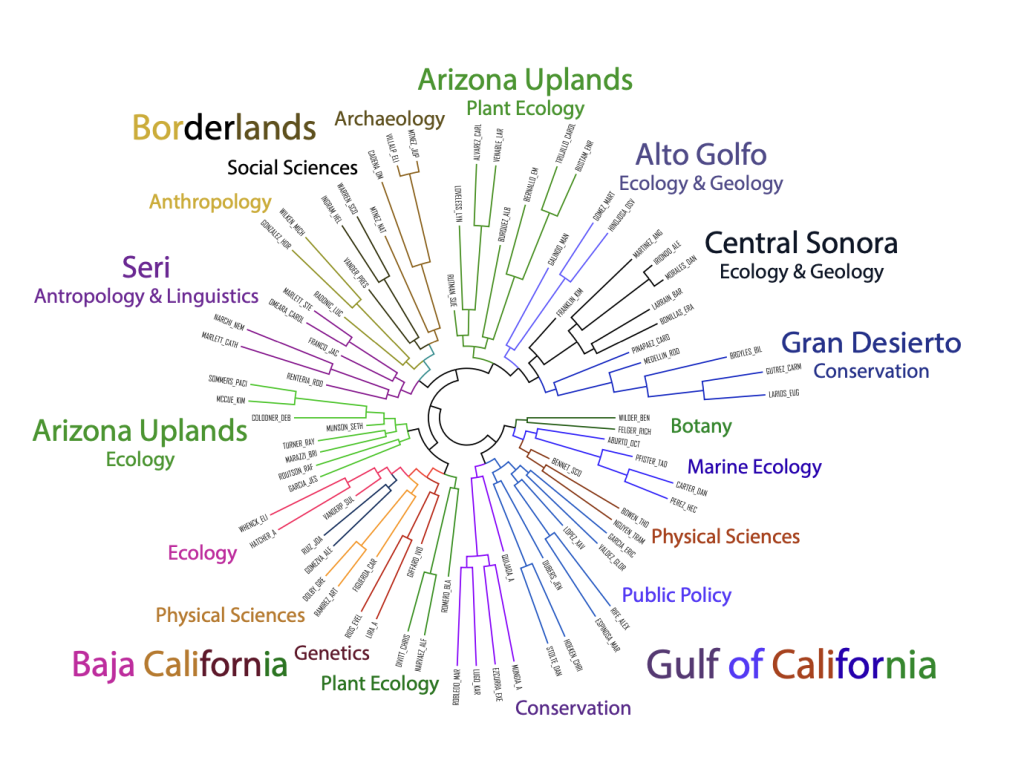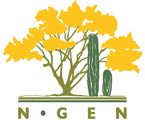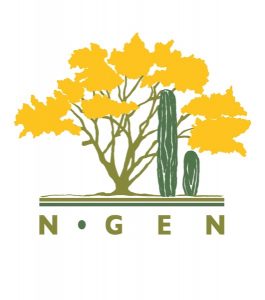
Title: Social Networks/Redes Sociales
Convener: Jennie Duberstein
Participants: Jennie Duberstein, Marlu, Hector, Elisa Villapando, Natalia, Alberto Burquez, Martha Gomez, Adrian Quijada, Tad Pfister, Juan Alvarez, Enriquena, Omar, Mike Wilken, Sue Rutman, Alan Hatcher, Helen Ingram, Lyn Lowley, Xavier Lopez Medellin, Horacio Gonzalez, Carolyn O’Meara, Tom Beal, Eric Garcia, Maria Jose Espinosa, Steve Marlett, Octavio Aburto, Alexis Rife, Andres Liza, Jupiter Martinez, Tram Nguyen, Pacifica Sommers
Discussion:
Despite the long history in the region, there is a need to better understand the connections of those working to conserve and understand the Sonoran Desert. The goal of this session was to propose a social network analysis of the participants of the Next Generation Sonoran Desert Researchers (Un)Conference. Goals of this analysis would include:
1. Improve our understanding of the connections between the different members of this community. What is the shape and size of the network? Who are the key players, where are the holes/gaps in communication?
2. Identify people who may be missing from the discussion and invite them to join. 3. Develop a mechanism for improved communication between network members (i.e., website where we can see the areas expertise of others, locations of field work, etc.) to improve future collaboration and sharing of knowledge. How can we apply our knowledge of this network to support sustainability of Sonoran Desert conservation (biological, cultural, etc.)?
The discussion had two arms: (1) social network analysis and (2) the need for social networking amongst those working in the Sonoran Desert.
Social network analysis is the actual study of the connections between us. The results of this analysis would be very interesting to conference funders, could be useful for helping to secure more funding for future efforts, and will help us identify key players, holes in the network, etc.
Social networking is, in my opinion, substantially different than social network analysis, although the results of the analysis will be an important part of creating opportunities for networking. Social networking is an opportunity to interact with others working in the region. Either the existing Next Generation website or the creation of something like a Ning network could help build this space that will allow everyone to see others working in the region, provide opportunities for improved collaboration and communication, etc.
Methodology
Develop a survey to apply to all conference participants in the weeks after this conference. The survey would gather both demographic information about individual respondents as well as more detailed network information about how each person in the conference is connected to others.
The initial goal is to develop this survey as quickly as possible after the conference and to do everything possible to achieve a complete response from all conference attendees.
During the session we discussed many different ideas for information to be gathered, all of which is stated below. The actual survey will likely be much shorter in order to gather the basic necessary information while not making the survey instrument unwieldy.
The resulting network analysis might include:
Strength of weak ties (the idea that people to whom we don’t have very strong connections may be very important since they tend to have information that we do not)
Strength of interdisciplinary ties (who are the people who have connections to others in different disciplines?
Do these connections lead to interdisciplinary research? Does this ultimately benefit conservation of the Sonoran Desert?)
Strength of intergenerational ties—how are the “next generation” researchers connected to the previous generations?
Can we provide opportunities to build these connections and help past research inform current and future efforts?
Do these ties help capture past history and experiences to keep them from being lost?
How can we encourage communication among network members?
How can we develop resilient/strong/durable binational networks for Sonoran
Desert conservation?
Possible demographic questions:
Name
Work history (in what areas have you worked—NGO, government, academia, etc.)
Where do you currently work (institution)
Where do you work (geography—communities, states, lat/longs; consider scale)
What languages do you speak? (Read, write, communicate)
What is your Nationality?
What is your primary discipline?
# of years working in your discipline
Age
Who were your mentors?
o Do you mentor others? Who? (Would you be interested in mentoring others?)
Where does your knowledge/information come from about the Sonoran Desert?
Flow of resources (financial, human): where does your funding come from?
Where does it go?
Publications—what are the significant books, species, habitats for your work?
What are your touchstones? (Could build networks around these things)
In the last XX years, what experiences, publications, oral histories, stories, etc. have impacted your work/live/passion most strongly?
How much do you work across disciplines?
How do you consider yourself (‘desert rat’)—discipline, Nationality
o Do you love the Sonoran Desert because you work here, or do you work here because you love it?
What are your specific skills (not just your overall discipline, but things like GIS, etc.)
What field experiences have you had (consider bimodal network of people by conferences/field experiences/etc.)
What listservs do you belong to?
Gender
Education level
o Where did you study?
Ideas for networks to study
Where do you get your information?
Who do you communicate with about your work in the region?
To measure tie strength, consider
Frequency of communication
o (in addition to frequency, could ask “how influential has this relationship
been to your work?)
o HOW do people work together?
Know personally/share information/knowledge
Read their work
Know name, but have not met personally
Collaborate on projects
Publishedsttogether
Met for 1 time at Next Generation conference
Other
Other thoughts:
Cluster analysis of disciplines
Include those without computer access
Importance of face-to-face communication
Test hypothesis of disappearance of institutional/individual ties (longitudinal
network analysis)
How can we make this analysis useful—create a web interface where people can
add themselves to the network.
Consider indigenous and rural communities who may not be physically
represented here at the conference.
Consider adding art, photography.
Important to clearly define goals of network/analysis; ask: where do we go from
here? How can we use these results?
Locate network spatially (i.e., on website create a map that shows the study areas
of each researcher/institution—would help find possible collaborators, identify
gaps, etc.)


